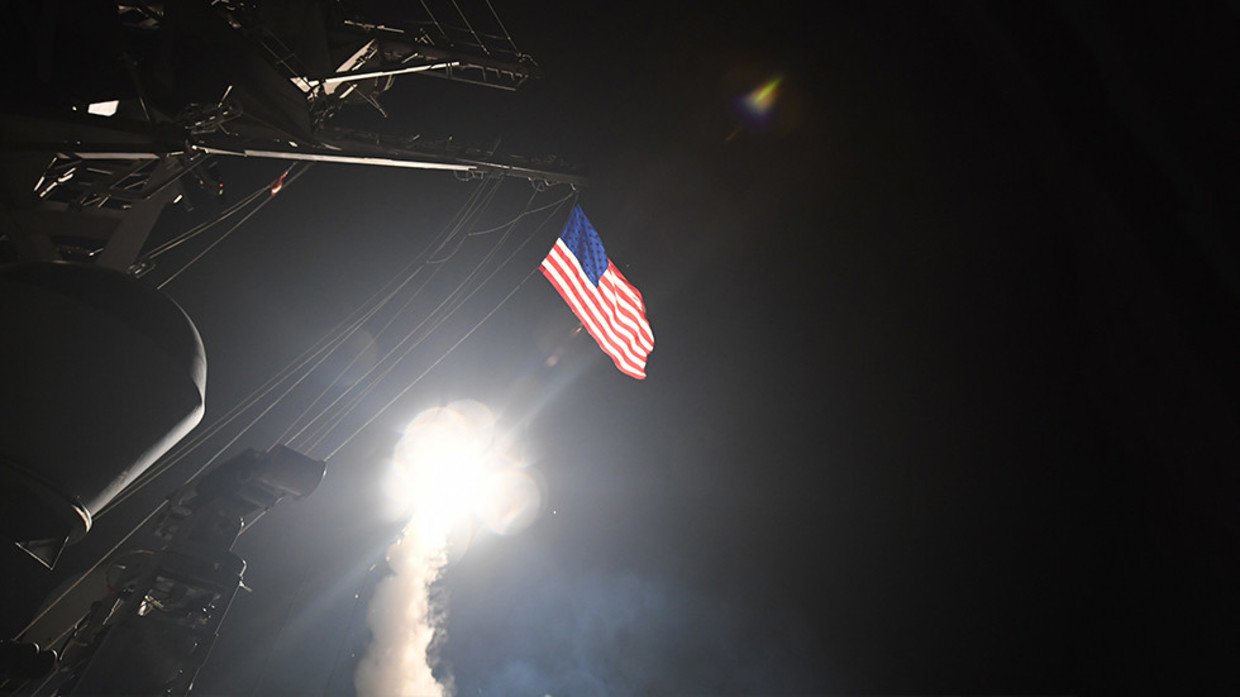A recent missile test confirmed by the Pentagon is stoking fears of a newly established arms race which would include, among others, Russia and China.
On August 18, North Korea tested a previously banned ground-launch missile with a range of over 500km, sending the entire world into an enormous, frenzied panic. Oh no, it was the United States which in fact tested the missile to the sound of crickets over Western media discourse.
The missile in question was likely a Tomahawk missile (at a cost of at least $1.4 million per missile, but then again you can’t put a price on wanton death and destruction), which is typically launched from ships and submarines – as we saw in Trump’s infamous April 2017 Syria strike.
It sounds like a waste of money (to me, anyway) but there’s a reason why Tomahawks cost a fortune. According to Popular Mechanics, a modern-day Tomahawk is guided by GPS and has the capacity to store coordinates for several targets. If a primary target was destroyed by friendly strikes, it can “take a picture of the damage done and loiter nearby until planners decide to re-attack the target or send the missile to attack an alternate.”
Also on rt.com US tests cruise missile BANNED by expired INF treatyI think this is what some commentators are referring to when they speak of US weapons systems as being more “humanitarian” than its adversarial counterparts. One day it may even wait while you finish your meal before it decides to rain down on you and your family.
Under the Intermediate-Range Nuclear Forces (INF) Treaty signed by Ronald Reagan and Mikhail Gorbachev, weapons with a range between 500km (310 miles) and 5,500km (3,417 miles) were banned. As we know, the US ripped up the treaty in spectacular fashion and within weeks began escalating tensions right across the geopolitical chessboard. Analysts are right to fear that these events are kick-starting a new cold war and arms race.
Despite nonsensical claims that Donald Trump was elected to represent Russian President Vladimir Putin’s interests in the United States, this move is a colossal slap in the face of Russia-US relations. This is in part due to the use of the Mark 41 Vertical Launching System, as these launchers are positioned at US missile defense sites in Poland and Romania.
This positioning was already seen as a violation of the INF Treaty. In 2016, Putin issued a direct warning against the sequence of events which continues to unfold before our eyes, saying at the time:
“They say [the missile systems] are part of their defense capability, and are not offensive, that these systems are aimed at protecting them from aggression. It’s not true… the strategic ballistic missile defense is part of an offensive strategic capability, [and] functions in conjunction with an aggressive missile strike system.”
“How do we know what’s inside those launchers? All one needs to do is reprogram [the system], which is an absolutely inconspicuous task,” Putin added, claiming that essentially, a ‘defensive’ missile system can very quickly become an offensive system.
Also on rt.com ‘One possible conclusion’: US banned-missile test apparently in works long before leaving INFThis is further compounded by the fact that the Pentagon claimed the missile was “conventionally configured” – in other words, not nuclear-equipped. But it wouldn’t take a genius to see how the US military could eventually begin firing nuclear-equipped missiles at similar length.
And don’t get me started on the hypocrisy of Washington’s actions. While repeatedly denouncing North Korea for launching missiles, the US (and it’s media arm) are seemingly quiet about the fact that the US not only is testing missiles that could pulverise North Korea, but that the US is one of the only nations in the world that actively tests missiles and deploys them for practical use in a number of theatres. North Korea – currently bombing no one – is branded as a rogue threat to global security, while the US, which, generally speaking, bombs more countries than can be counted on one hand, is allowed to exit treaties and test intermediate range missiles all with free reign.
Of course, Russia was not naïve enough to think that these events were not going to unfold. Russia had already suspected that the US would quit the INF Treaty, and the speed with which it has begun testing banned missiles seems to give Russian officials the impression that these tests were in the pipeline for some time.
It is difficult to see how all of this fits in with Trump’s view of himself as the world’s best dealmaker, and the extent to which these are all just ploys for him to create new deals. Just as Trump has used maximum pressure on Iran to try to forcibly drag Tehran to the negotiating table (presumably, to establish a new deal which includes, for example, Iran’s missile tests), there are more than enough indications that one of Trump’s aims is to draw up a new treaty which would include Beijing, as well. Beijing, of course, is not having any of this proposal.
As I wrote two weeks ago, the US likely abandoned the INF Treaty because it placed no constraints on China, examining statements such as this one from Defense Secretary Mark Esper, that “80 percent plus of their [Beijing’s] inventory is intermediate range systems, so that shouldn’t surprise them that we would want to have a like capability.”
Also on rt.com Why did the US exit INF Treaty? What you’re not being toldAt the time, a Sydney-based think tank released a pretty damning report concluding that China’s “growing arsenal of accurate long-range missiles poses a major threat to almost all American, allied and partner bases, airstrips, ports and military installations in the Western Pacific.”
As if the US required further support for the idea that it needs to boost its missile capabilities, the report further stated that: “As these facilities could be rendered useless by precision strikes in the opening hours of a conflict, the PLA [People’s Liberation Army] missile threat challenges America’s ability to freely operate its forces from forward locations throughout the region.”
I imagine some of you are by now growing tired of listening to me blaming most geopolitical problems on the United States, but in all honesty, it simply becomes too easy after a while. North Korea is a perfect example. According to Trump himself, Kim Jong-un has said he will stop missile-testing if the US stops its joint military drills with South Korea. This is something many of us have said countless times, but no one will listen.
READ MORE: NATO's broken promises: Time to admit West bears serious responsibility for tension in E. Europe
So, in most cases, you have the US instigating the problem, the US continuing the problem, and most importantly, the US reneging on its word multiple times and exiting agreements left and right, and the rest of the world is left to its own devices to determine how best to move forward.
Recently revealed documents have quite clearly established that the US made multiple promises to the Soviet Union that NATO would expand “not one inch eastward.” NATO not only continues to expand, but so too might its intermediate range missile capabilities as happily provided by the US directly on Russia’s border.
Like this story? Share it with a friend!
The statements, views and opinions expressed in this column are solely those of the author and do not necessarily represent those of RT.


